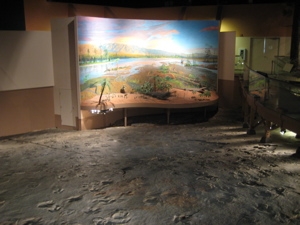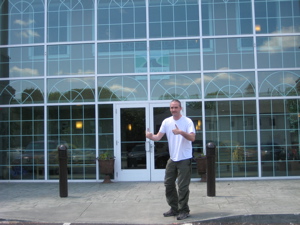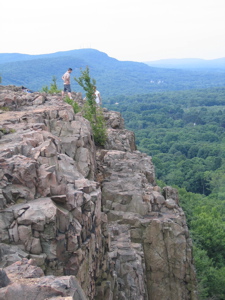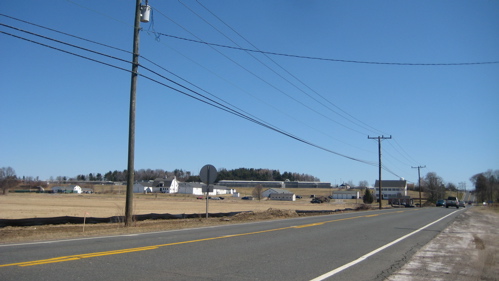XVII. National Natural Landmarks, Trails, et. al.
CTMQ is Going National Part 2
National Natural Landmarks (8)
National Scenic Byways (2)
National Heritage Corridor/Area (2)
National Scenic Trails (2)
National Historic Trails (2)
National Natural Landmarks (8)
 I really dig this category. For starters, I had never heard of such a designation. Also, I’ve been to or been very near 5 of the 8 landmarks already and had no idea. Most of these aren’t exactly vacation destinations as they seem to be in other states, especially out west. But they’re ours and that’s all I need. And while one is mostly in Massachusetts (Bartholemew’s Cobble), I am drawn to it anyway because it has North America’s greatest diversity of ferns. I find that rather awesome.
I really dig this category. For starters, I had never heard of such a designation. Also, I’ve been to or been very near 5 of the 8 landmarks already and had no idea. Most of these aren’t exactly vacation destinations as they seem to be in other states, especially out west. But they’re ours and that’s all I need. And while one is mostly in Massachusetts (Bartholemew’s Cobble), I am drawn to it anyway because it has North America’s greatest diversity of ferns. I find that rather awesome.
The National Natural Landmark (NNL) program recognizes and encourages the conservation of outstanding examples of the United States’ natural history. It is the only natural areas program of national scope that identifies and recognizes the best examples of biological and geological features in both public and private ownership. The program was established on May 18, 1962 by United States Secretary of the Interior Stewart Udall.
The program aims to encourage and support voluntary preservation of sites that illustrate the geological and ecological history of the United States, and to strengthen the public’s appreciation of the country’s natural heritage. As of June 2005, 587 sites have been added to the National Registry of National Landmarks. The registry includes nationally significant geological and ecological features in 48 states, American Samoa, Guam, Puerto Rico, and the Virgin Islands. (My childhood home of Delaware has none. So sad.)
The National Park Service administers the NNL Program, and if requested, assists NNL owners and managers with the conservation of these important sites. Land acquisition by the federal government is not a goal of this program; NNLs are nationally significant sites owned by a variety of land stewards, and participation in the program is voluntary. NNLs are not National Parks. NNL status does not indicate public ownership, and many sites are not open for visitation – though Connecticut’s 8 are, for the most part.

McLean Game Refuge woods in Autumn
Designation of a National Natural Landmark presently constitutes only an agreement with the owner to preserve, insofar as possible, the significant natural values of the site or area. Administration and preservation of Natural Landmarks is solely the owner’s responsibility. Either party may terminate the agreement after they notify the other.
Well, that kind of sucks. But as you’ll see, these are some incredibly random and interesting natural landmarks to say the least.
National Natural Landmarks program
1. Dinosaur Trackway, Rocky Hill – CTMQ NNL Report
2. Bartholemew’s Cobble, Canaan
3. Bingham Pond Bog , Salisbury – CTMQ NNL Report
4. Chester Cedar Swamp, Chester – CTMQ NNL Visit
5. McLean Game Refuge Natural Areas, Simsbury/Granby - CTMQ NNL Report
6. Pachaug-Great Meadow Swamp, Voluntown
7. Beckley Bog, Norfolk – CTMQ NNL Visit
8. Cathedral Pines, Cornwall
…………………………………………………….
National Scenic Byways (2)
Get yer motor runnin’…. Head out on the National Scenic Byways… Looking for CTMQ Adventure…
 Y’know, I kind of hate that song. I don’t really “get” this one as it seems to be commercially sponsored and not wholly a federal program. It seems to pretty much just be a national version of the state scenic road designation, but it certainly does have some federal backing and they’ve certainly chosen two good “byways” here in Connecticut.
Y’know, I kind of hate that song. I don’t really “get” this one as it seems to be commercially sponsored and not wholly a federal program. It seems to pretty much just be a national version of the state scenic road designation, but it certainly does have some federal backing and they’ve certainly chosen two good “byways” here in Connecticut.
The National Scenic Byways (NSB) Program was established under the Intermodal Surface Transportation Efficiency Act of 1991, and reauthorized in 1998 under the Transportation Equity Act for the 21st Century. Under the program, the U.S. Secretary of Transportation recognizes certain roads as National Scenic Byways or All-American Roads based on their archaeological, cultural, historic, natural, recreational, and scenic qualities. There are 151 such designated Byways in 46 states. The Federal Highway Administration promotes the collection as the America’s Byways®.
This program is founded upon the strength of the leaders for individual Byways. It is a voluntary, grassroots program. It recognizes and supports outstanding roads. It provides resources to help manage the intrinsic qualities within the broader Byway corridor to be treasured and shared. Perhaps one of the underlying principles for the program has been articulated best by the Byway leader who said, “the program is about recognition, not regulation.”
The vision of the Federal Highway Administration’s National Scenic Byways Program is “To create a distinctive collection of American roads, their stories and treasured places.” Their mission is to provide resources to the byway community in creating a unique travel experience and enhanced local quality of life through efforts to preserve, protect, interpret, and promote the intrinsic qualities of designated byways.
As you can imagine, I’ve driving these things plenty of times – the Merritt too many to count. There are a ton of CTMQ stops along Route 169 and heck, the Merritt even has a museum dedicated to it.
1. Connecticut State Route 169, Lisbon to Woodstock, 32 Miles (Info)
(Someday I’ll list out all the CTMQ attractions along the route.)
2. Merritt Parkway, Greenwich to Stratford, 37 Miles – Merritt Parkway Museum
…………………………………………………….
National Heritage Corridor/Area (2)
By far the most ill-defined of these national things. They are vast, both cross into Massachusetts and there’s no real way to “visit” Connecticut’s National Heritage Areas. I’m also fairly certain that almost everyone who reads this sentence has never even heard of our two Heritage Areas either. That’s not to say there isn’t cool stuff within them, or that I can’t try to “define” them for CTMQ purposes. Oh, you know I’ll try.
A National Heritage Area is a site designated by United States and intended to encourage historic preservation of the area and an appreciation of the history and heritage of the site. There are currently 49 National Heritage Areas, some of which use variations of the title, such as National Heritage Corridor.
National Heritage Areas are not National Park Service units nor any type of federally-owned or managed land. National Heritage Areas are administered by state governments or non-profit organizations or other private corporations. The National Park Service provides an advisory role and limited technical, planning and financial assistance.
Both contain other CMTQ-worthy stops within them. But before you check ours out, just look at some of these kooky places that have been federally designated Silos and Smokestacks National Heritage Area anyone? Seriously.
1. Quinebaug and Shetucket Rivers Valley National Heritage Corridor – The Last Green Valley – Northeast corner of the state (Info) and CTMQ Page
Lots to do here… I’ll keep you updated.
2. Upper Housatonic Valley National Heritage Area – Info
…………………………………………………….
National Scenic Trails (2)
 Ahh, my favorite. It’s pretty darn cool that the Appalachian Trail enjoys such a lofty status – as it should. But even cooler, in 2009 the feds recognized the Mattabesett- Metacomet trail that bisects Connecticut as one of the 11 total (as of this writing) worthy trails. Okay yeah, both the AT and the MMM trails continue on into other states, but that makes no difference to me. I’ve hiked the AT before (but will do the CT section again for CTMQ) and most of the MM trail (as of this writing), but the Mattabesett is being extended down to the Long Island Sound as a result of the recent designation – yay, more hiking for me.
Ahh, my favorite. It’s pretty darn cool that the Appalachian Trail enjoys such a lofty status – as it should. But even cooler, in 2009 the feds recognized the Mattabesett- Metacomet trail that bisects Connecticut as one of the 11 total (as of this writing) worthy trails. Okay yeah, both the AT and the MMM trails continue on into other states, but that makes no difference to me. I’ve hiked the AT before (but will do the CT section again for CTMQ) and most of the MM trail (as of this writing), but the Mattabesett is being extended down to the Long Island Sound as a result of the recent designation – yay, more hiking for me.
National Historic Trail is a designation for a protected area in the United States containing historic trails and surrounding areas. National Historic Trails were authorized under the National Trails System Act of 1968
1. Connecticut Section of the Appalachian Trail
2. Connecticut Section of the New England Scenic Trail
Mattabesett Trail
Metacomet Trail
…………………………………………………….
National Historic Trails (2)
This one has caused me a bit of confusion. First – and this isn’t confusing – these “trails” aren’t hiking trails whereas the Scenic Trails above are. These are historic trails where some, um, important history took place at some point in our county’s history. One of ours traverses the entire state from east to west and has a very important, very concrete story behind it. It’s also very new so aside from a few signs alongside roads, there’s not much to it yet (though there are a few museums, monuments and parks related to it along the way.)
The other, the Shaker Historic Trail, isn’t listed on Wikipedia but does have a website clearly run by the National Park Service. Our little piece of that trail is a little (no longer) Shaker Village area up in Enfield. I believe I’m correct in including it here.
National Historic Trail is a designation for a protected area in the United States containing historic trails and surrounding areas.
National Historic Trails were authorized under the National Trails System Act of 1968 (Public Law 90-543) along with National Scenic Trails and National Recreation Trails. National Scenic Trails and National Historic Trails may only be designated by an act of Congress.
1. Washington-Rochambeau Revolutionary Route National Historic Trail
(Info)
2. Shaker Historic Trail, Enfield – CTMQ Visit (Info)

Enfield Shaker houses from afar






Leave a Comment